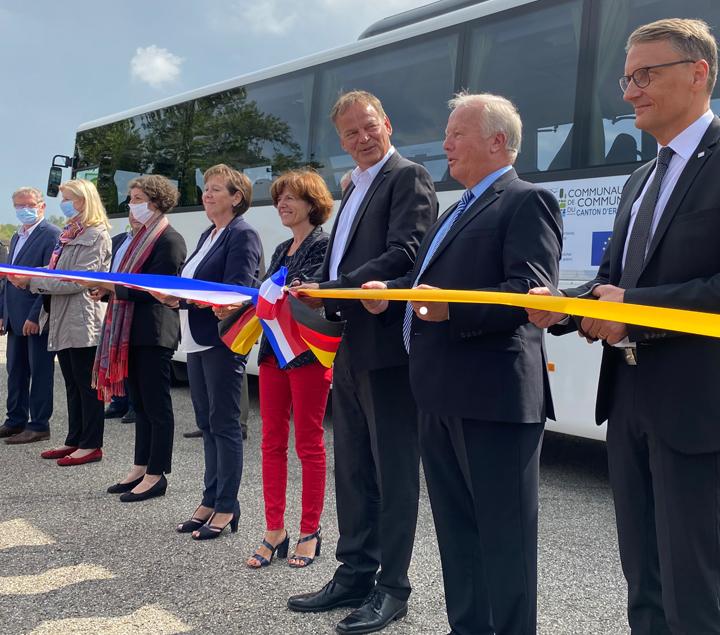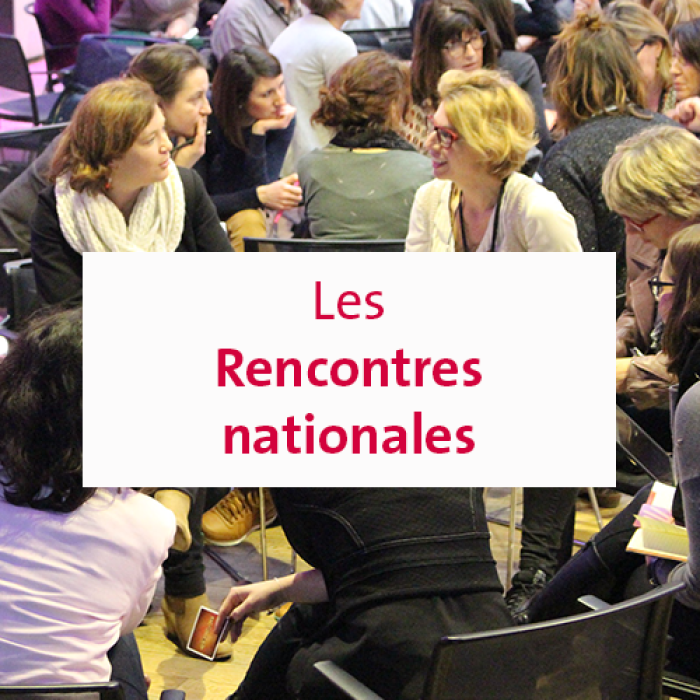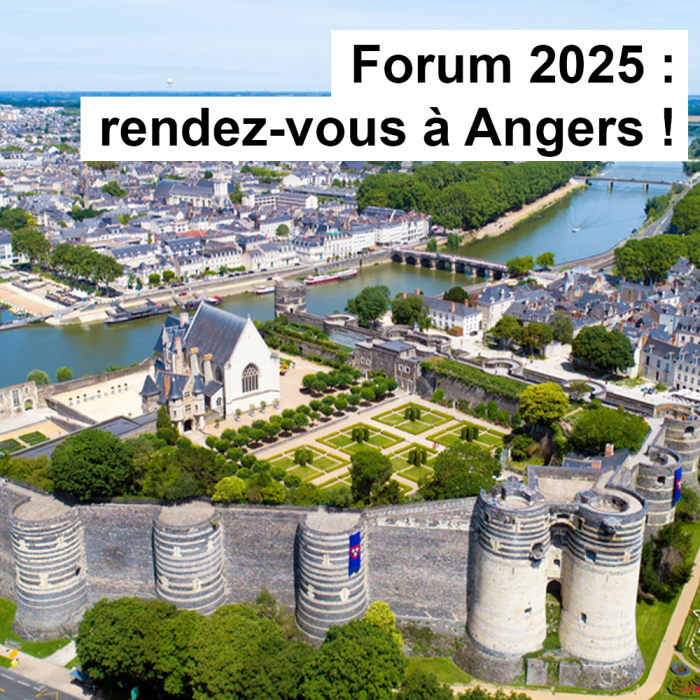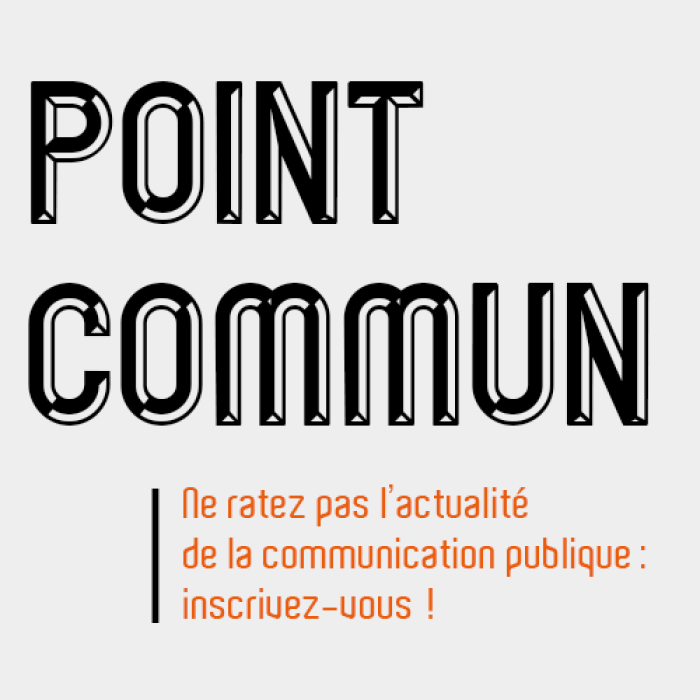
Promoting Europe within regions
Where better than Strasbourg to discuss public communication at European level? At the Forum on 16 November last year, six speeches gave an overview of the issues involved in communication in and with the European Union.
Main photo: inauguration of the Erstein-Lahr 280, the first public cross-border bus line in the Strasbourg-Ortenau Eurodistrict, in September 2020. Credit: © Olivier Claudel.
Article based on reports by Malo Fortier and Guillaume Clery, Master’s students in Communication, Facilitation and Innovation in Regions at the University of Rennes 2, and Alexandre Arnould, Cyrille Macron and Guilhem Roux, Master’s students in Political Science, Public Communication and Participative Democracy at the University of Lille.
Home to the European Parliament, Council of Europe and the European Court of Human Rights, Strasbourg inspired public communication officers from all over France for a “hop” conference on “Initiatives to promote Europe within Regions”. Led by Gael Lecomte, president of WBCom’ (the French-speaking Belgian Association of public communication officers), this session set out to highlight initiatives in meeting the challenges of communicating about and with Europe, particularly in cross-border areas.
It was also an opportunity to look at various cases where European aspects play a role in regional projects and in their communication. It’s not as simple as it sounds, once we take into account certain mistrust on the part of European citizens towards political Europe. This is particularly the case in France, which the 2022 Statista survey places at the top of the list of Eurosceptic countries: 53% of French people would not trust the European Union. How could Europe appear to be more useful in regions? What difference does it make to communication strategies?
Supporting a cross-border bus line
One of the speeches focused on communication on cross-border bus lines in the Strasbourg-Ortenau Eurodistrict between France and Germany. This is perhaps the simplest illustration of the challenges involved in international communication. Resulting from cooperation between two neighbouring regions, this project has a strong political angle and raises the question of multiple target audiences and languages. The project initially involved a bus line created solely for cross-border employees. The 280 bus line, more commonly known as the Erstein-Lahr cross-border line, was introduced in 2020, subsequent to studies on the mobility of locals and with partnerships with the municipalities and regions concerned. The aim was obviously to include users of the line, in order to ensure the responses met the requirements.
Communication on this project can be described as “traditional”, with visits organised for the press of both countries. But it is the users who are today at the centre of the scheme and, through their mobility, create cross-border communication on a daily basis. For Katrin Neuss, head of communication, press and events at Strasbourg-Ortenau Eurodistrict, it was vital to “put the emphasis on Europe. As the words Europe s’invente chez nous were written on the side of the bus, we might as well drive this idea home!” This is just the start of the project, with several more lines planned for the Eurodistrict.
Bringing regions together
Staying with cross-border regions, let’s now take a look at Luxembourg, and Alzette-Belval. in particular. This region comprises eight towns and is known as an “Operation of National Interest”, abbreviated to OIN. France has 15 of these regions. Alzette-Belval has a special place among these OINs, because, unlike others, it is neither in nor adjoining a metropolitan area. This area has several urban planning aspects, and not just that of renovating a district.
Successfully communicating on a European dimension that often seems distant and obscure.
Indeed, this region has a number of brownfield sites, as well as zones with ecological issues, straddling both agricultural and urbanised sectors. Lastly, and this is what really makes this OIN different, Alzette-Belval has been created in cooperation with another project, namely that of Esch-Belval, located... in Luxembourg.
The difficulty also lay in how to successfully communicate on a European dimension that often seems distant and obscure. The problem here was that many local players falied to understand what Europe was doing in this OIN. Work was therefore required to create better understanding of how Europe was involved as a partner – not only as a geopolitical area – and what it was going to do to revive the region.
To achieve this, the communication department chose to use the example of the Micheville eco-district and work on educating people about the project. Located on an industrial wasteland, the eco-district renovation project, comprising an eco-park, culture hub and 2,000 housing units, was granted ERDF (European Regional Development Fund) funding which was of “significant help” according to Hélène Bisagra, head of development for the Alzette-Belval public development corporation. She explained that “to publicise this subsidy, the Be Europe en Grand-Est website was created and used to demonstrate the various types of funding available, as well as showcasing projects completed thanks to European subsidies. There is however progress to be made, particularly in terms of communication and consultation.”
Europe at all levels
This financing aspect was detailed and explained to the public communication officers attending the conference by Laurence Lapôtre, Senior Manager at Algoé and in charge of funding collaborative innovation. She talked about the diversity of the programs and calls for projects.
For projects to have a chance of funding, emphasis has to be given to its partners and region.
Effective communication “is always a key step for a projects to have a chance of funding and emphasis has to be given to its partners and region.” Successfully understanding who the target of specific funding is and setting up effective communication to reach this target, while succeeding in clarifying it for the funding body, are just some of the public communication challenges to be met by the heads of communication of regions engaged in this path.
But the challenges of international communication are even more diverse. An example would be an approach to communication determined by linguistic issues. Such as in Liège, Belgium, in the intercultural mediation service of the Citadelle Hospital, a free service created in 1998, involving seven mediators, in addition to an in-house group of volunteer translators. There are some 150 different nationalities in the hospital and 42 nationalities among the 4,000 employees. The idea was therefore to target the most common languages and enable patients to receive better care through mediation. Their mediators therefore have a dozen languages (including sign language) between them, but as they are not full-time, the mediation service also relies on a list of volunteers among the hospital’s employees. In terms of communication, the service’s work involves adding to and maintaining this list and letting patients and hospital staff know that the list exists and that they can use it. For Laurie-Anne Barla, head of communication at the Citadelle Hospital, “the next key challenge for the service will be to translate and produce brochures accessible to as many people as possible.”
Europe, where are you?
Finally, other aspects of European public communication were raised by Gaia Manco, head of citizen engagement projects at the European Parliament, and by consultant, Julien Joxe. Ms. Manco looked back at the European cettefoisjevote.eu and ensemble.eu campaigns to create closer ties and engagement, from the 2019 elections to the present-day community. Mr. Joxe made a final contribution on the Agenor project forcefully and with conviction. He evoked Greek mythology to represent today’s challenges, with the figure of Agenor, king of Tyre, who asked his three sons to go in search of their lost sister... who was called Europe!






